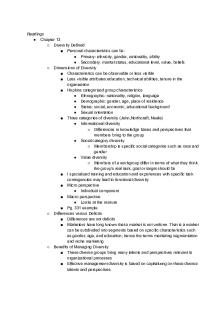SCM Paper 6 - Dr. Formby PDF

| Title | SCM Paper 6 - Dr. Formby |
|---|---|
| Author | Taylor Bumgarner |
| Course | Supply Chain Management |
| Institution | Appalachian State University |
| Pages | 1 |
| File Size | 49.6 KB |
| File Type | |
| Total Downloads | 32 |
| Total Views | 149 |
Summary
Dr. Formby...
Description
This week we were assigned to do some research on two companies: Aldi’s and Trader Joe’s. Aldi’s is a German-owned discount chain that provides a small selection of private label products at rockbottom prices. Trader Joes also happens to be owned by the same Albrecht family trust (the Al in Aldi’s). So what is the difference between them? Well, a recent New York Times article seems to point out that the only difference is that Trader Joe’s actually has somewhat of a marketing budget whereas Aldi’s hardly does any marketing at all. The general idea behind both stores is this: to take away some of the variety and level of choice that the supermarkets and superstores have, and provide instead a very similar private label brand at a fraction of the cost. This is a very similar strategy to the one that was presented to us by Sav-A-Lot in the in-class presentation. By doing this, they have achieved a smaller footprint for the actual building, and therefore save cost immediately on rent/building materials, electricity, and other utilities. Implementing this strategy also greatly reduces transportation costs because instead of having to purchase or manufacture 100,000 different items, these stores average about 1500 items. Up to 95% of these items bear a private label. As we take a closer look at Aldi’s, we see that everything that the company implements is in the best interest of cost savings. Just taking a step inside an Aldi’s and you will see that it is pretty selfexplanatory, it is a compact, efficient, no extra bells and whistles to get in your way. While they may not have your favorite brand of a particular item, they most likely provide a private label substitute at about 50% of the cost. So, while shopping at Aldi’s may give you a different experience than a higher-end supermarket or superstore, it is worth it for many customers to take away the frills and save a good bit of money. Trader Joe’s is remarkably similar to Aldi’s in the general strategy of cutting down the unnecessary cost from larger supermarkets, but with several key differences. About 80% of Trader Joe’s shelves are from their own private label brands, slightly less than Aldi’s. Also, Trader Joe’s has a mission to provide food from “around the globe, or around the corner”, so they do also offer some local items as well. Recently, with the growth of the Trader Joe’s Brand, now Aldi’s carries some of the Trader Joe’sspecific items in their stores. Trader Joe’s is also involved in the effort to be more environmentally friendly, phasing out food products from China, and actively trying to replace products with unhealthy ingredients such as GMOs, MSG, and trans fats. Trader Joe’s is also the exclusive retailer of Charles Shaw wine, popularly known as Two Buck Chuck, which has exploded in popularity along the west coast where Trader Joe’s originated. In Conclusion, Aldi’s and Trader Joe’s are sister companies who are both great alternatives to giant chain superstores and supermarkets, with Aldi’s being more back-to-basics and keeping bottom dollar pricing a priority, and Trader Joe’s having more of a marketing presence and a slightly broader selection of products. https://en.wikipedia.org/wiki/Trader_Joe%27s http://consumerist.com/2011/03/30/aldi-is-trader-joes-for-the-rest-of-us/...
Similar Free PDFs

SCM Paper 6 - Dr. Formby
- 1 Pages

SCM paper 13 - Dr. Formby
- 1 Pages

SCM paper 11 - Dr. Formby
- 2 Pages

Lecture 6 - SCM m.m.
- 4 Pages

SCM CIA-II Question Paper
- 1 Pages

SCM CIA-I Question Paper
- 1 Pages

SCM Chapter 6 Answer Key
- 13 Pages

SCM-4-Master Budget - SCM
- 21 Pages

Paper 6
- 8 Pages

Long Paper 1 - Dr. Richard
- 6 Pages

Module 6 - Dr. Reams
- 13 Pages

Lecture 6 - Dr Jamie Barker
- 2 Pages

Chapter 6 Review - Dr. Budden
- 3 Pages

WEEK 6 Group Paper
- 8 Pages

APS - Paper 1 - Dr. Sarah Cate
- 6 Pages
Popular Institutions
- Tinajero National High School - Annex
- Politeknik Caltex Riau
- Yokohama City University
- SGT University
- University of Al-Qadisiyah
- Divine Word College of Vigan
- Techniek College Rotterdam
- Universidade de Santiago
- Universiti Teknologi MARA Cawangan Johor Kampus Pasir Gudang
- Poltekkes Kemenkes Yogyakarta
- Baguio City National High School
- Colegio san marcos
- preparatoria uno
- Centro de Bachillerato Tecnológico Industrial y de Servicios No. 107
- Dalian Maritime University
- Quang Trung Secondary School
- Colegio Tecnológico en Informática
- Corporación Regional de Educación Superior
- Grupo CEDVA
- Dar Al Uloom University
- Centro de Estudios Preuniversitarios de la Universidad Nacional de Ingeniería
- 上智大学
- Aakash International School, Nuna Majara
- San Felipe Neri Catholic School
- Kang Chiao International School - New Taipei City
- Misamis Occidental National High School
- Institución Educativa Escuela Normal Juan Ladrilleros
- Kolehiyo ng Pantukan
- Batanes State College
- Instituto Continental
- Sekolah Menengah Kejuruan Kesehatan Kaltara (Tarakan)
- Colegio de La Inmaculada Concepcion - Cebu
